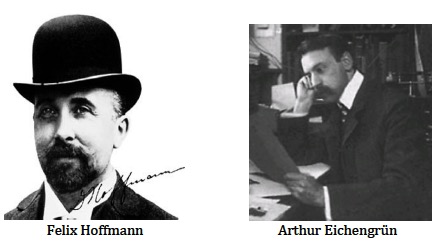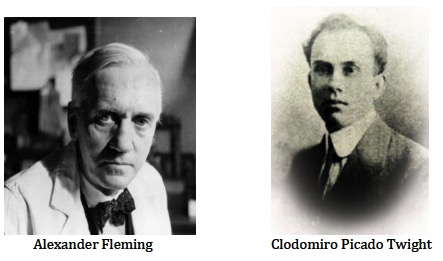D.2 Aspirin & penicillin
Written specifically for students to provide help and support for the IB Diploma chemistry programme this page provides full coverage of the syllabus content of Option D - sub topic D.2. It encourages you to think critically and provides many questions with full worked answers so that you can monitor and improve your knowledge and understanding.
.png)

 Learning outcomes
Learning outcomes
After studying this topic you should be able to:
.png) Understand:
Understand:
- Aspirin, and other mild analgesics, function by intercepting the pain stimulus at the source. They interfere with the production of substances responsible for pain, swelling or fever.
- Aspirin can be prepared from salicylic acid.
- Aspirin is also used as an anticoagulant, to prevent the recurrence of heart attacks and strokes and as a prophylactic.
- Penicillins are antibiotics produced by fungi.
- Part of the core structure of penicillins consists of a beta-lactam ring.
- Some antibiotics function by preventing the cross-linking of bacterial cell walls.
- Penicillins can be made more resistant to the penicillinase enzyme by modifying the side-chain.
- Describe the use of salicylic acid and its derivatives as mild analgesics.
- Explain the synthesis of aspirin from salicylic acid, including yield, purity by recrystallisation and characterization using infrared spectroscopy and melting point.
- Discuss the synergistic effects of aspirin with alcohol.
- Discuss how aspirin can be chemically modified into a salt to increase its solubility in water and how this facilitates its bioavailability.
- Discuss the effects of chemically modifying the side-chain of penicillins.
- Discuss the importance of patient compliance and the effects overprescribing penicillin.
- Explain the importance of the beta-lactam ring on the action of penicillin.
Relationships & vocabulary
Nature of science
The discovery of penicillin by Sir Alexander Fleming is one of the classic examples of serendipity in science - although there is some doubt that he was in fact the first person to discover it.
Many drugs have been isolated, identified and modified from natural sources. One example is derivatives of salicylic acid, obtained from the bark of the willow tree, which are used to relieve pain and fever.
International-mindedness
Aspirin is used worldwide and has several different uses.
The discovery and use of antibacterials has changed the way that disease is treated throughout the world and contributed to an increase in life-expectancy.
Vocabulary
| analgesic | synergy | antibiotic | antibacterial |
| anticoagulant | beta-lactam ring | overprescription | salicylic acid (2-hydroxybenzoic acid) |
Learning slides
You can use this slide gallery for learning or for reviewing concepts and information. It covers all the key points in the syllabus for this sub-topic.
Something to think about
It seems rather strange to me to have a sub-topic covering just aspirin and penicillin as they would appear to have little in common – even the ‘Understandings’ and ‘Applications and skills’ in the Guide list them under different headings. In previous versions of the programme, aspirin, together with paracetamol and ibuprofen, formed a sub-topic on mild analgesics and penicillin was part of a separate sub-topic on antibacterials.
However they do have one rather quirky thing in common and that is that their history of discovery in both cases is controversial.
Most sources state that aspirin was discovered in 1897 by Felix Hoffmann who was working for the Bayer Company in Germany at the time. The story goes that Hoffmann’s father suffered from arthritis and encouraged his son to develop an alternative treatment to sodium salicylate. Sodium salicylate is the sodium salt of salicylic acid obtained from the willow tree bark. It had been used for centuries as a painkiller and for the treatment for fever, but has several unpleasant side effects, including nausea, gastro-intestinal irritation, tinnitus and liver damage. This story first appeared only as a footnote in 1934 in a history of chemical engineering written by Albrecht Schmidt. Schmidt was an employee of IG Farbenindustrie, which had amalgamated with the Bayer Company in 1925. It seems likely however that another scientist working at Bayer in 1897 really deserves the credit. In 1949 Arthur Eichengrün (1867 - 1949) claimed that the work had been done under his direction and analysis of relevant archival and published material appears to support this claim. The reason it was not accepted at the time is that Eichengrün was a Jew and Jews were persecuted in Nazi Germany in the 1930s. In fact Eichengrün spent fourteen months in the Theresienstadt concentration camp.
Who discovered aspirin - Felix Hoffmann or Arthur Eichengrün?

Alexander Fleming is almost universally recognised as having made the serendipitous discovery of penicillin in 1928. Fleming was not able to stabilise the penicillin that he found and it was left to Florey and Chain during World War II to really develop it as an effective antibacterial. Fleming made his discovery while he was working at St Mary’s Hospital in London. One of the trustees of the hospital was Lord Beaverbrook who was a newspaper magnate and he used his power of the press to promote the story about Fleming. In fact the use of moulds to prevent infections has existed in folklore for a long time. In 1923 a Costa Rican, Clodomiro Picado Twight (1887 - 1944), working in Paris recorded the action of the fungal genus Penicillium sp. on the growth of bacteria, and his work was published in 1927, two years before Fleming published, but Clodomiro Twight has received little recognition outside of Costa Rica for his discovery.
Who discovered penicillin - Alexander Fleming or Clodomiro Picado Twight?

Test your understanding of this topic
(Note that your teacher may have restricted your access to some or all of these questions and worked answers if they are going to use them as a class test or set them as an assignment.)
For ten 'quiz' questions (for quick testing of knowledge and understanding with the answers explained) see MC test: Aspirin & penicillin.
For short-answer questions see Aspirin & penicillin questions together with the worked answers on a separate page Aspirin & penicillin answers.
More resources
1. An informative article on taking aspirin for heart conditions and the risks associated with it has been produced by Patient UK. Another article also by Patient UK gives useful information on how mild painkillers work.
2. A useful podcast from the Royal Society of Chemistry on
3. A short video students will enjoy by Richard Thornley on the synergistic effects of taking alcohol with aspirin.
4. A good short video on how aspirin (and ibuprofen) prevent pain by TEDEd.
5. One of the first films on the discovery of penicillin was produced by the Wellcome Foundation in 1964. Rather patriotic (in British terms!) and very dated but worth showing.
6. A fairly simple description of how penicillins work by Tim Newman at about the right level for Standard Level students can be found in Medical News Today.
7. An interesting paper describing work done at Warwick University to understand how the penicillin resistant bacterium streptococcus pneumoniae is able to build up its immunity to penicillin.

 IB Docs (2) Team
IB Docs (2) Team 
























